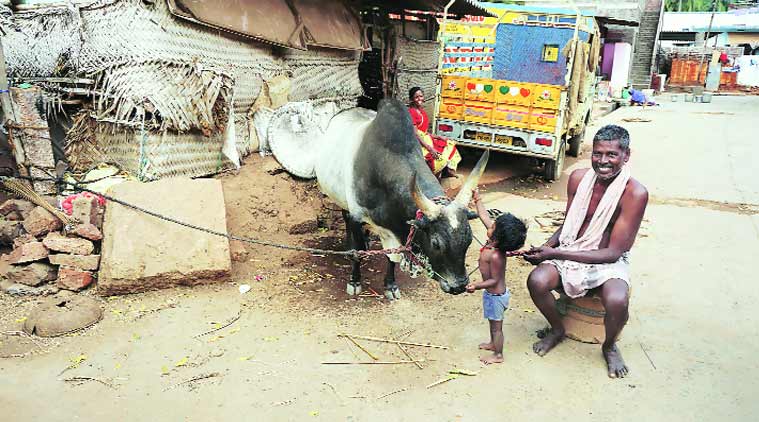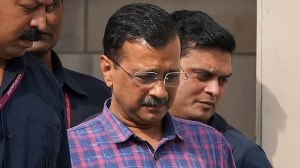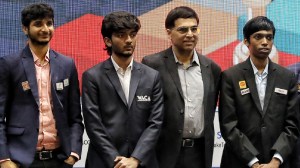- India
- International
Bull’s-eye
Distress sales have begun after Pongal last month saw no bull-taming in TN’s jallikattu belt. But Selvam can’t imagine selling the bull he named after his son.
 Selvam with Raja and grandchild Yuvaraja. The bull is nicest to the child, he says. (Source: Express Photo by Arun Janardhanan)
Selvam with Raja and grandchild Yuvaraja. The bull is nicest to the child, he says. (Source: Express Photo by Arun Janardhanan)A day in the life of R Selvam, 60, a Jallikattu bull owner in Tamil Nadu.
R selvam, 60, lives just a few yards from vaadi vasal — the narrow passage through which jallikattu bulls would be let loose into his village Alaganallur’s sporting arena. From his house he can see the two galleries built for the spectators as well as the banyan tree, next to the village temple, from which trophies won by Alaganallur bulls are still strung.
In the courtyard of his house, where Selvam spends most of his day, his one-and-a-half-year old grandchild Yuvaraja is playing with Raja, his own jallikattu bull.
The bull-taming sport was banned by the Supreme Court in May last year under the Prevention of Cruelty to Animals Act and this Pongal (celebrated mid-January) was the first time that Alaganallur, 20 km from Madurai, did not see jallikattu. Alaganallur, in the jallikattu belt of Tamil Nadu, used to be one of its most high-profile venues.
[related-post]
But for Selvam, the tradition that goes back nearly 4,000 years and is canonised in Tamil literature and popular culture is a part of his daily life. Just the other day, some people came knocking on his door to buy Raja, whom Selvam named after his only son. They had procured more than 100 bulls, they told him. He chased them away saying he couldn’t sell what was to him like his own child.

The sale of bulls started after Pongal, and now Selvam is one of the few bull owners left in Alaganallur. Jallikattu bulls are in high demand due to the quality of their flesh.
Selvam says more than 300 jallikattu bulls have been sold in the past week alone in the Sunday cattle markets of Vadipatti and Melur near Madurai. “The price of the bulls has come down to Rs 30,000-50,000 from more than Rs 2 lakh,” he says.
Many sent them away crying. In most homes, the bulls shared living quarters with family members and were not even kept in cattle sheds.
Smiling indulgently at Yuvaraja’s antics, Selvam says, “He is better than me in giving him commands. Raja knows how to handle children.”
However, maintaining Raja is getting tougher by the day. Selvam needs Rs 300 daily just to keep Raja well-fed. “A jallikattu bull should be well-nourished as he is the symbol of the village’s pride. Now, many people do not see a reason to rear the bulls,” he says. The prized bulls were raised on a diet of cottonseed, coconut, brinjal and dates, and grew up to 350-400 kg.
That made for a formidable spectacle at jallikattu, where tamers were required to tackle the giant animals by their hump and try to hang on to them till they crossed the finishing line — generally a matter of a few seconds. Those who managed to stay on the bull were winners; and the bulls that remained untamed were celebrated. For the owners, the returns were not monetary but measured by the honour of having their bull remaining untamed.
Selvam was once a jallikattu hero, but stopped working about five years ago after a road accident. The house runs on the earnings of his son Raja, 35, who works at a stone quarry. As he sits in the courtyard next to Raja the bull, Selvam says, “I have to be here throughout the day. Raja is like a little baby. For us, handling Yuvaraja is easier than handling him.”
Come evening, G Madan, an erstwhile bull handler, joins Selvam. Most of their talk revolves around the families that have sold their bulls.
Madan says the Supreme Court ban is misplaced. “Jallikattu was not a competitive sport. It was an event to honour bull owners who reared stud bulls for mating. Bull owners were honoured with a dhoti, towel, betel leaves, bananas and token cash that rarely exceeded Rs 101, on a silver plate. The bull-taming event itself lasted only a few minutes,” he says.
At the end of the event, all the bulls were considered winners and awarded the same prize, Madan adds.
Villagers blame “people from the city” who got alarmed at the bull-taming as having brought upon the ban. Activists talked of bulls getting injured, and goring spectators as well as tamers, to argue for the ban.
Since March 2006, however, when a judge directed Tamil Nadu to prevent cruelty to animals in the form of bullock-cart races and other games involving cattle, jallikattu had become tamer. The Tamil Nadu Jallikattu Peravai, a group of bull owners and patrons, says there have been virtually no casualties since 2007.
Balakumar Somu, a former IT executive with HP who runs a website on jallikattu, fears the ban will have an impact on the population of native cattle breeds of Tamil Nadu. Villagers who could not afford to have a stud bull used to depend on jallikattu bulls, who were also attached to temples, he says. “The number of events had dropped from over 3,000 before 2006 to just about 24 towards the ban period in May 2014. Pure-breed native stud bulls have dropped to less than a thousand in number,” Somu says.
“If I could, I would bring the judges and animal activists to my village and show them what jallikattu is about and how we take care of these bulls,” says Selvam.
Behind him, at vaadi vasal, M Pappuamma is praying at the temple. The 65-year-old invokes all the gods she knows, convinced that Alaganallur, already drought-stricken, would not get any rain if jallikattu stays banned.
Apr 23: Latest News
- 01
- 02
- 03
- 04
- 05






































